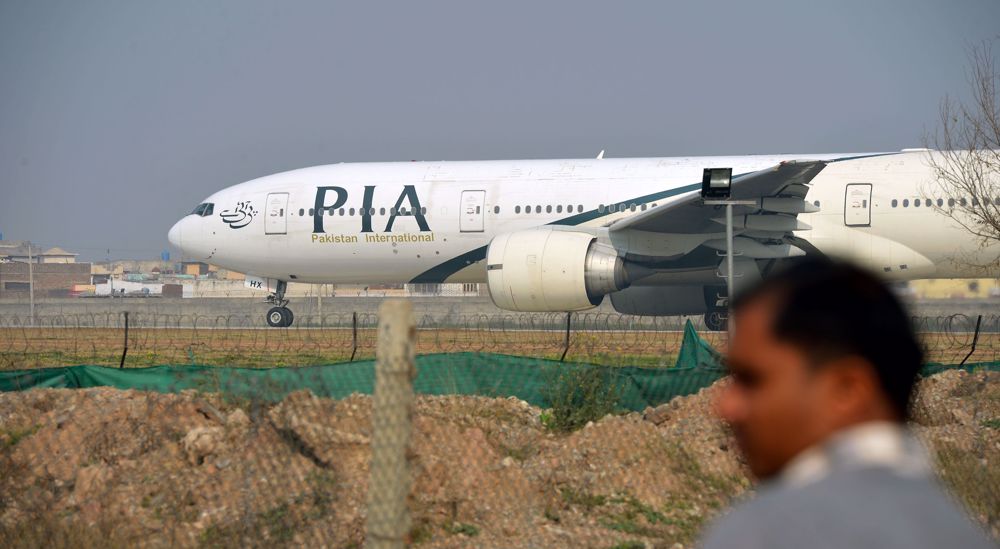Pilots in Pakistan air crash distracted by coronavirus worry: Report
The pilots of a Pakistan airliner that crashed last month, killing 97, were distracted and preoccupied as they talked about the coronavirus pandemic while preparing for an initial failed landing bid, the country’s aviation minister told parliament as he presented an initial report on the disaster.
The Airbus A320 of national carrier Pakistan International Airlines crashed on May 22 in the southern city of Karachi, killing all but two of those aboard as it came down a kilometer (0.6 mile) short of the runway on its second attempt.
The aircraft had landed on its engines on the first attempt, before taking off again, the minister, Ghulam Sarwar Khan, told lawmakers.
The flight data recorder showed the landing gear was lowered at 10 nautical miles, Khan said, but then raised again 5 nautical miles from the runway, which he described as "beyond comprehension."
The aircraft was "100 percent fit to fly" and there was no technical fault, he said, but added that the pilots were not "focused" because of the pandemic.
"The discussion throughout was about corona," Khan said, referring to exchanges between the pilot and co-pilot he said he had listened to on the cockpit voice recorder.
"Corona was dominant over their mind. Their family was affected (by the virus)."
The report, reviewed by Reuters, did not spell out the pilots' conversation on the virus, but said they did not follow set protocols.
"Several warnings and alerts such as over-speed, landing gear not down and ground proximity alerts, were disregarded," it added. "The landing was undertaken with landing gear retracted. The aircraft touched the runway surface on its engines."
Both the pilots and officials at air traffic control did not follow set procedures, Khan said.
"The captain and the co-pilot were experienced and medically fit," the minister said.
Khan added that the data showed flight PK8303 from the eastern city of Lahore was at an altitude of just 7,220 feet (2,200 meters) when 10 miles (16 kilometers) from the runway, although it should have been at 2,500 feet (762 meters).
Air traffic control drew the pilot's attention to the irregularity, and advised against landing, instead urging a go-around, Khan said.
"When they were in landing position, they were warned by the controllers, but he said, 'I'll manage'… and then they started discussing corona again."
He said the inquiry report revealed the pilot had mentioned no technical fault during the final approach.
"The last words from the pilot were, 'Oh God, oh God, oh God,'" Khan added.
Pakistan has recorded 188,926 infections and 3,755 deaths in the virus pandemic, with a big spike in reported cases over the last month.
The county's deadliest aviation accident in eight years came days after domestic commercial flights resumed following a two-month coronavirus lockdown.
Pakistan has a chequered military and civilian aviation safety record, with frequent plane and helicopter crashes over the years.
In 2016, a PIA plane burst into flames after one of its two turboprop engines failed while flying from the remote north to Islamabad, killing more than 40 people.
The deadliest air disaster in Pakistan was in 2010 when an Airbus A321 operated by private airline Airblue and flying from Karachi crashed into the hills of Islamabad as it came in to land, killing all 152 people on board.
An official report blamed the accident on a confused captain and a hostile cockpit atmosphere.
PIA, one of the world's leading airlines until the 1970s, now suffers from a sinking reputation due to frequent cancellations, delays and financial troubles.
(Source: Agencies)
Iran sets decade-long plan to raise oilseed self-sufficiency
VIDEO | Historic monuments of India’s heritage capital crumbling under chronic neglect
China rejects Israel’s recognition of Somaliland
VIDEO | Winter deepens the suffering of displaced families in northern West Bank camps
Russia says Ukraine tried to attack Putin's residence with 91 drones
Palestine Action hunger striker Heba Muraisi losing ability to speak
Halbousi elected speaker as Iraq moves towards government formation
Muslim scholar decries silence on Israel's Gaza crimes as betrayal of Islamic principles












 This makes it easy to access the Press TV website
This makes it easy to access the Press TV website